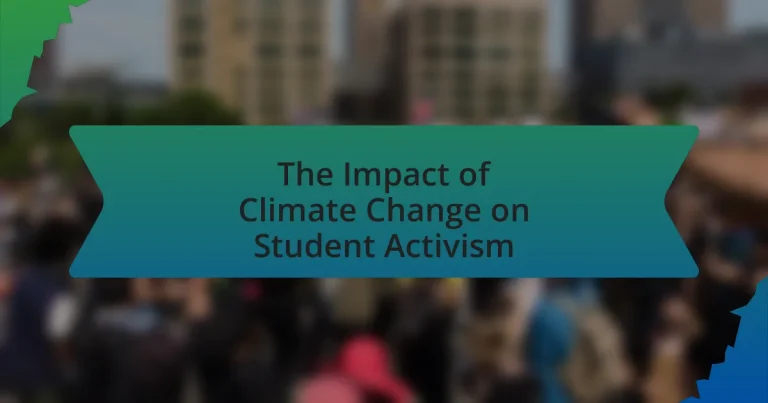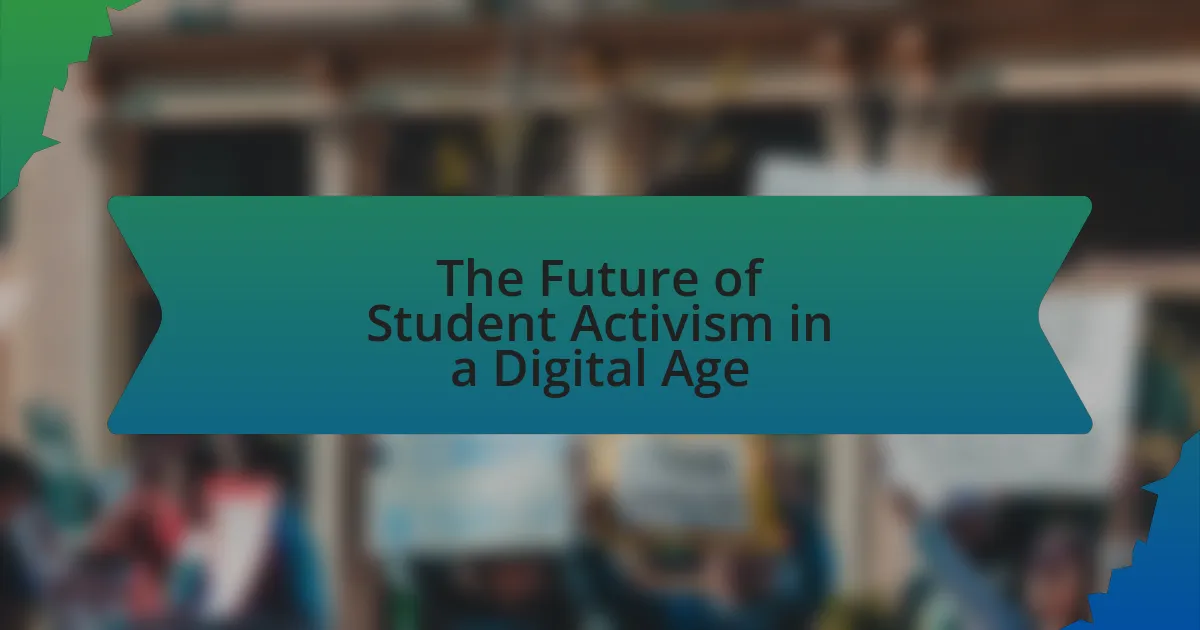The article examines the impact of climate change on student activism, highlighting how rising global temperatures and extreme weather events have mobilized youth to advocate for environmental policies. It discusses the historical events that have shaped this activism, such as the Paris Agreement and global climate strikes, and explores regional variations in student engagement based on local climate impacts. The article emphasizes the importance of student activism in influencing policy changes and raising awareness about climate issues, detailing the strategies employed by movements like Fridays for Future and the challenges faced by student activists. Additionally, it outlines practical steps students can take to enhance their activism and sustain engagement over time.
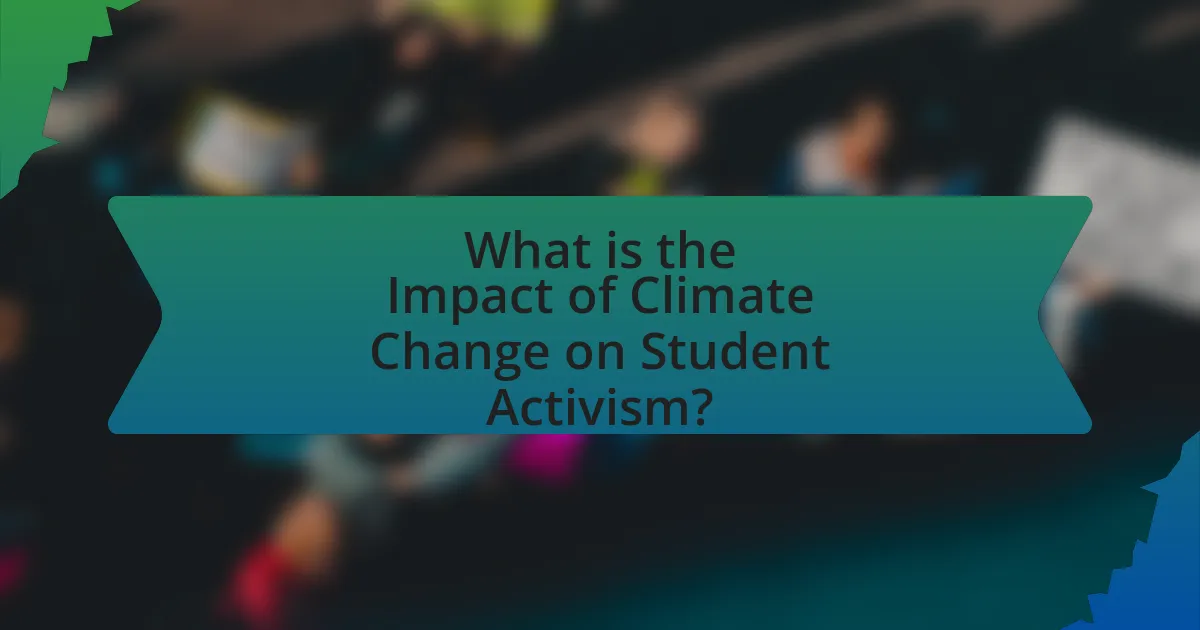
What is the Impact of Climate Change on Student Activism?
Climate change significantly influences student activism by increasing awareness and mobilizing youth around environmental issues. As global temperatures rise and extreme weather events become more frequent, students are increasingly motivated to advocate for policy changes and sustainable practices. For instance, the global climate strikes initiated by students, such as those inspired by Greta Thunberg, have drawn millions of participants, highlighting the urgency of climate action. Research indicates that 74% of young people feel that climate change is a crisis, prompting them to engage in activism to demand governmental accountability and systemic change. This heightened engagement reflects a broader trend where climate change serves as a catalyst for political and social activism among younger generations.
How has climate change influenced the rise of student activism?
Climate change has significantly influenced the rise of student activism by increasing awareness and urgency around environmental issues. As scientific evidence mounts, such as the Intergovernmental Panel on Climate Change reports indicating that human activities are driving unprecedented climate changes, students have mobilized to demand action from governments and institutions. This activism is exemplified by movements like Fridays for Future, initiated by Greta Thunberg, which has inspired millions of students globally to participate in climate strikes and advocate for sustainable policies. The emotional and existential impact of climate change on younger generations has further galvanized their commitment to activism, leading to a notable increase in organized protests and campaigns aimed at addressing climate-related challenges.
What historical events have shaped student activism in response to climate change?
Historical events that have shaped student activism in response to climate change include the 2015 Paris Agreement, the 2018 Global Climate Strike initiated by students, and the 2021 COP26 summit. The Paris Agreement galvanized youth movements by establishing international climate goals, prompting students to demand accountability from their governments. The Global Climate Strike, inspired by Greta Thunberg’s solitary protest, mobilized millions of students worldwide, highlighting the urgency of climate action. Additionally, COP26 served as a platform for student activists to voice their concerns and influence global policy discussions, further solidifying their role in climate advocacy. These events collectively demonstrate the growing influence of student activism in the climate change discourse.
How do different regions experience climate change’s impact on student activism?
Different regions experience climate change’s impact on student activism through varying levels of urgency and engagement, influenced by local environmental conditions and socio-political contexts. For instance, in coastal areas facing rising sea levels, students often mobilize for immediate action, as seen in regions like Bangladesh, where youth-led movements advocate for climate justice due to frequent flooding. Conversely, in regions with less visible climate effects, such as parts of the United States, activism may focus more on policy advocacy and awareness campaigns rather than immediate survival issues. Studies indicate that students in Europe, particularly in countries like Sweden, engage in activism through organized strikes and global movements, reflecting a strong cultural emphasis on environmental sustainability. This regional disparity highlights how local climate impacts shape the nature and intensity of student activism, with evidence showing that areas experiencing direct climate threats tend to foster more urgent and grassroots mobilization efforts.
Why is student activism important in the context of climate change?
Student activism is crucial in the context of climate change because it mobilizes young people to advocate for urgent environmental policies and raise awareness about climate issues. This demographic, often more affected by the long-term consequences of climate change, has demonstrated significant influence through movements like Fridays for Future, which has inspired millions globally to demand action from governments and institutions. Research indicates that youth-led initiatives can lead to substantial policy changes; for instance, a study by the University of California found that student protests have been linked to increased legislative attention to climate policies. Thus, student activism serves as a powerful catalyst for societal change regarding climate action.
What role do students play in advocating for climate policies?
Students play a crucial role in advocating for climate policies by mobilizing public awareness and influencing political action. Through organized movements like Fridays for Future, initiated by Greta Thunberg, students have demonstrated their ability to galvanize global attention on climate issues, leading to significant policy discussions and commitments from governments. Research indicates that youth activism has increased pressure on policymakers, with over 1.4 million students participating in climate strikes worldwide in 2019, showcasing their impact on public discourse and legislative agendas.
How does student activism contribute to broader societal change regarding climate issues?
Student activism significantly contributes to broader societal change regarding climate issues by mobilizing public awareness and influencing policy decisions. For instance, movements like Fridays for Future, initiated by Greta Thunberg, have galvanized millions of students worldwide, leading to increased media coverage and public discourse on climate change. This heightened awareness often pressures governments to adopt more stringent environmental policies, as seen in countries like Sweden, where youth activism has directly influenced national climate legislation. Furthermore, student-led initiatives often promote sustainable practices within educational institutions, creating a ripple effect that encourages communities to adopt similar measures.
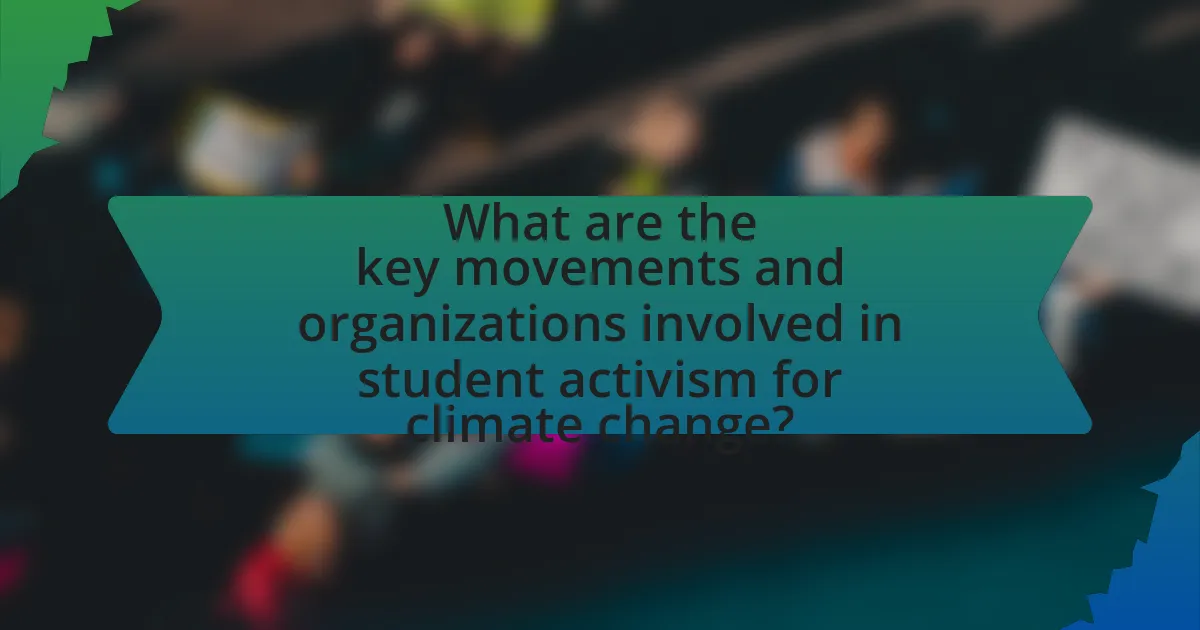
What are the key movements and organizations involved in student activism for climate change?
Key movements and organizations involved in student activism for climate change include Fridays for Future, Extinction Rebellion Youth, and the Sunrise Movement. Fridays for Future, initiated by Greta Thunberg in 2018, mobilizes students globally to demand urgent climate action, leading to significant protests and awareness campaigns. Extinction Rebellion Youth focuses on nonviolent civil disobedience to highlight the climate crisis, while the Sunrise Movement advocates for political action in the United States, particularly around the Green New Deal. These organizations have collectively engaged millions of students, influencing public discourse and policy on climate change.
Which prominent student-led movements have emerged globally?
Prominent student-led movements that have emerged globally include the Fridays for Future movement, initiated by Greta Thunberg in 2018, which mobilizes students to advocate for climate action through school strikes. Another significant movement is the Sunrise Movement in the United States, which focuses on promoting a Green New Deal and engaging youth in climate policy advocacy. Additionally, the School Strike for Climate movement has seen participation from millions of students worldwide, emphasizing the urgency of addressing climate change. These movements have gained traction through social media, leading to widespread awareness and activism among young people regarding environmental issues.
What strategies do these movements employ to raise awareness?
Student activism movements employ strategies such as social media campaigns, public demonstrations, and educational outreach to raise awareness about climate change. Social media platforms enable activists to reach a global audience quickly, facilitating the sharing of information and mobilizing support for climate initiatives. Public demonstrations, like climate strikes, draw attention to the urgency of the issue, often resulting in significant media coverage that amplifies their message. Educational outreach in schools and communities helps inform peers and the public about climate science and the importance of action, fostering a culture of environmental responsibility. These strategies collectively enhance visibility and engagement, driving the conversation around climate change and its impacts.
How do these movements collaborate with other organizations?
Student activism movements collaborate with other organizations through partnerships, joint campaigns, and resource sharing. For instance, groups like Fridays for Future often work alongside environmental NGOs, educational institutions, and local governments to amplify their message and mobilize larger audiences. This collaboration is evidenced by events such as climate strikes, where student activists coordinate with organizations like Greenpeace and the Sierra Club to organize protests and raise awareness about climate issues. Additionally, these movements leverage social media platforms to connect with global networks, facilitating the exchange of strategies and support, which enhances their impact on climate policy and public opinion.
What challenges do student activists face in their efforts?
Student activists face significant challenges in their efforts, including institutional resistance, lack of resources, and societal apathy. Institutional resistance often manifests as pushback from school administrations or government entities that may view activism as disruptive. For instance, in 2019, students in the United States faced disciplinary actions for participating in climate strikes, highlighting the risks associated with activism. Additionally, lack of resources, such as funding and access to platforms for organizing, hampers their ability to mobilize effectively. A study by the International Institute for Environment and Development found that many student-led initiatives struggle due to insufficient financial backing and logistical support. Lastly, societal apathy can undermine their efforts, as public indifference to climate issues can lead to low engagement in activism. This combination of factors creates a challenging environment for student activists striving to effect change regarding climate change.
How do political and institutional barriers affect student activism?
Political and institutional barriers significantly hinder student activism by limiting access to resources, suppressing free speech, and imposing bureaucratic obstacles. For instance, universities may enforce strict regulations on protests and demonstrations, which can discourage students from organizing and participating in activism related to climate change. Additionally, political climates that are hostile to environmental issues can lead to a lack of institutional support for student-led initiatives, as seen in cases where administrations prioritize funding for programs that align with governmental policies over student activism efforts. Research indicates that when students face punitive measures for activism, such as disciplinary actions or surveillance, their willingness to engage in collective action diminishes, thereby stifling movements aimed at addressing climate change.
What are the psychological impacts of activism on students?
Activism has significant psychological impacts on students, including increased feelings of empowerment, anxiety, and social connectedness. Engaging in activism can enhance students’ sense of agency, as they feel they are contributing to meaningful change, which can boost self-esteem and motivation. However, the emotional toll of confronting issues like climate change can lead to heightened anxiety and stress, particularly when students perceive the challenges as overwhelming or insurmountable. Research indicates that students involved in activism often report stronger social bonds and a sense of community, which can provide emotional support and mitigate feelings of isolation. A study published in the Journal of Environmental Psychology found that students participating in climate activism experienced both positive psychological growth and negative emotional responses, highlighting the complex nature of their experiences.
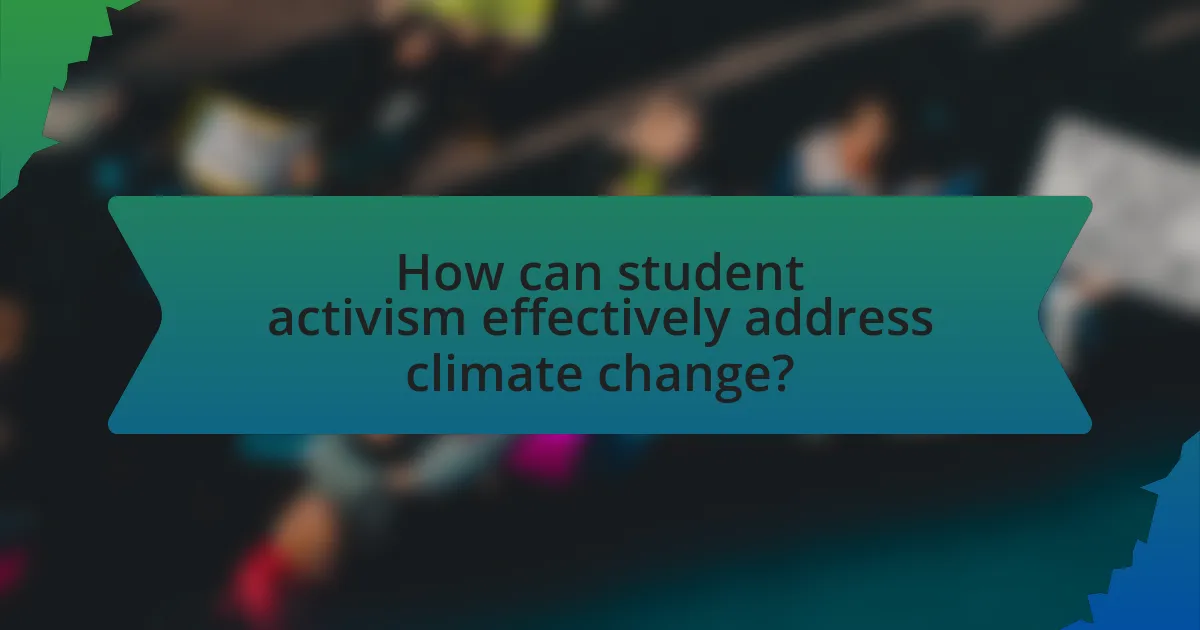
How can student activism effectively address climate change?
Student activism can effectively address climate change by mobilizing collective action, raising awareness, and influencing policy changes. Through organized protests, campaigns, and educational initiatives, students can highlight the urgency of climate issues, as evidenced by movements like Fridays for Future, which has inspired millions globally to demand action from governments. Research indicates that youth-led movements significantly impact public opinion and policy, with a 2021 study published in the journal “Nature Climate Change” showing that increased youth activism correlates with heightened political engagement and climate policy advancements. By leveraging social media platforms, students can amplify their messages, connect with like-minded individuals, and hold institutions accountable for their environmental practices.
What strategies can students adopt to enhance their activism?
Students can enhance their activism by engaging in organized campaigns, utilizing social media platforms, and collaborating with local communities. Organized campaigns allow students to focus their efforts on specific issues, such as climate change, and mobilize support through events and petitions. Social media platforms serve as powerful tools for raising awareness, sharing information, and connecting with like-minded individuals, as evidenced by the global reach of movements like Fridays for Future, which began with a single student protest in Sweden and grew into a worldwide phenomenon. Collaborating with local communities enables students to address regional concerns and build grassroots support, fostering a sense of collective action that can lead to tangible change.
How can social media be leveraged for climate activism?
Social media can be leveraged for climate activism by facilitating widespread awareness, mobilizing communities, and amplifying voices advocating for environmental change. Platforms like Twitter, Instagram, and Facebook enable activists to share information rapidly, organize events, and engage with a global audience. For instance, the #FridaysForFuture movement, initiated by Greta Thunberg, gained international traction through social media, leading to millions participating in climate strikes worldwide. Research indicates that social media campaigns can significantly increase public engagement and support for climate initiatives, as evidenced by a study published in the journal “Environmental Communication,” which found that social media use correlates with heightened awareness and action regarding climate issues.
What role does education play in empowering student activists?
Education plays a crucial role in empowering student activists by equipping them with knowledge, critical thinking skills, and a sense of agency. Through education, students gain an understanding of social issues, including climate change, which fosters awareness and motivates them to take action. For instance, studies show that students who participate in environmental education programs are more likely to engage in activism related to climate issues, demonstrating a direct correlation between educational initiatives and increased activism. Furthermore, educational institutions often provide platforms for students to organize, collaborate, and amplify their voices, thereby enhancing their impact on societal change.
What are the best practices for sustaining student activism over time?
To sustain student activism over time, it is essential to establish strong networks and provide ongoing education and training. Strong networks facilitate collaboration and resource sharing among students, which enhances collective action. Ongoing education ensures that students remain informed about relevant issues, such as climate change, and can adapt their strategies accordingly. Research indicates that organizations with robust support systems and continuous learning opportunities are more effective in maintaining engagement and momentum (Della Porta & Diani, 2006). Additionally, creating a culture of inclusivity and diversity within activist groups fosters broader participation and resilience, as diverse perspectives can lead to innovative solutions and sustained interest.
How can students build coalitions with other activist groups?
Students can build coalitions with other activist groups by identifying shared goals and values, facilitating open communication, and organizing joint events. By recognizing common objectives, such as climate action or social justice, students can create a foundation for collaboration. Effective communication, including regular meetings and shared platforms, fosters trust and understanding among groups. Organizing joint events, such as rallies or educational workshops, not only amplifies their message but also strengthens their collective impact. Historical examples, such as the collaboration between youth climate activists and social justice organizations during the Global Climate Strikes, demonstrate the effectiveness of coalition-building in achieving broader social change.
What methods can be used to maintain engagement and motivation among activists?
To maintain engagement and motivation among activists, organizations can implement regular communication, provide opportunities for skill development, and foster a sense of community. Regular communication, such as newsletters or social media updates, keeps activists informed and connected to the cause, which is essential for sustained interest. Opportunities for skill development, like workshops or training sessions, empower activists by enhancing their capabilities and confidence, leading to increased motivation. Additionally, fostering a sense of community through events or collaborative projects creates strong interpersonal bonds, which research shows can significantly enhance commitment and enthusiasm among group members. For instance, a study by the University of California found that social connections within activist groups directly correlate with higher levels of sustained engagement.
What practical steps can students take to make a difference in climate activism?
Students can make a difference in climate activism by engaging in local environmental initiatives, advocating for sustainable practices on campus, and educating their peers about climate issues. Participating in community clean-up events or tree-planting activities directly contributes to environmental restoration. Additionally, students can form or join campus organizations focused on sustainability, which can amplify their voices and influence university policies regarding energy use and waste management. Research indicates that student-led movements, such as the Sunrise Movement, have successfully pressured institutions to adopt greener practices, demonstrating the effectiveness of collective action in climate advocacy.
